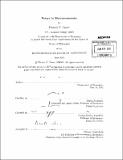| dc.contributor.advisor | Daron Acemoglu and George-Marios Angeletos. | en_US |
| dc.contributor.author | Nenov, Plamen T. (Plamen Toshkov) | en_US |
| dc.contributor.other | Massachusetts Institute of Technology. Dept. of Economics. | en_US |
| dc.date.accessioned | 2012-09-13T18:55:18Z | |
| dc.date.available | 2012-09-13T18:55:18Z | |
| dc.date.copyright | 2012 | en_US |
| dc.date.issued | 2012 | en_US |
| dc.identifier.uri | http://hdl.handle.net/1721.1/72837 | |
| dc.description | Thesis (Ph. D.)--Massachusetts Institute of Technology, Dept. of Economics, 2012. | en_US |
| dc.description | Cataloged from PDF version of thesis. | en_US |
| dc.description | Includes bibliographical references (p. 143-149). | en_US |
| dc.description.abstract | This thesis examines questions in macroeconomics motivated by the 2007-2008 financial crisis and its aftermath. Chapter 1 studies the impact of a housing bust on regional labor reallocation and the labor market. I document an empirical fact, which suggests that, by increasing the fraction of households with negative housing equity, a housing bust hinders interregional mobility. I then study a multi-region economy with local labor and housing markets and worker reallocation. A housing bust creates debt overhang for some workers, which distorts their migration decisions and increases aggregate unemployment in the economy. In a calibrated version of the model, I find that the regional reallocation effect of the housing bust can account for between 0.2 and 0.5 percentage points of aggregate unemployment and 0.4 and 1.2 percentage points of unemployment in metropolitan areas experiencing deep local recessions in 2010. Chapter 2 studies a model of endogenous fluctuations in credit market conditions. I consider an economy with productivity heterogeneity and durable capital. Entrepreneurs issue debt to buy capital but have superior information about the distribution of their future productivity and, hence, of their debt repayments. Additionally, limited pledgeability of high output realizations creates a wedge between the valuations of inside and outside investors. The combination of these two frictions leads to a new channel of interaction between the price of capital and the credit market, which in turn leads to multiple equilibria and fluctuations in output, the price of capital, and leverage across equilibria. I then use the model to analyze the effect of unconventional monetary policy by a central bank. Financial instability is often characterized by increased uncertainty, debt rollover difficulties and asset liquidation at depressed prices. Chapter 3, which is a joint work with Felipe Iachan, studies a debt roll-over coordination game with dispersed information and market-determined liquidity conditions. We describe conditions under which an improvement in the precision of individuals' information about financial institutions' fundamentals leads to greater financial stability. For the limiting case of arbitrarily precise private information, that condition obtains a simple form in terms of payoff elasticities. Finally, we discuss the effects of stress tests and the "living will" mandate from the Dodd-Frank act. We conclude that given our framework, the latter policy should have a large positive impact for financial stability. | en_US |
| dc.description.statementofresponsibility | by Plamen T. Nenov. | en_US |
| dc.format.extent | 149 p. | en_US |
| dc.language.iso | eng | en_US |
| dc.publisher | Massachusetts Institute of Technology | en_US |
| dc.rights | M.I.T. theses are protected by
copyright. They may be viewed from this source for any purpose, but
reproduction or distribution in any format is prohibited without written
permission. See provided URL for inquiries about permission. | en_US |
| dc.rights.uri | http://dspace.mit.edu/handle/1721.1/7582 | en_US |
| dc.subject | Economics. | en_US |
| dc.title | Essays in macroeconomics | en_US |
| dc.type | Thesis | en_US |
| dc.description.degree | Ph.D. | en_US |
| dc.contributor.department | Massachusetts Institute of Technology. Department of Economics | |
| dc.identifier.oclc | 807049639 | en_US |

